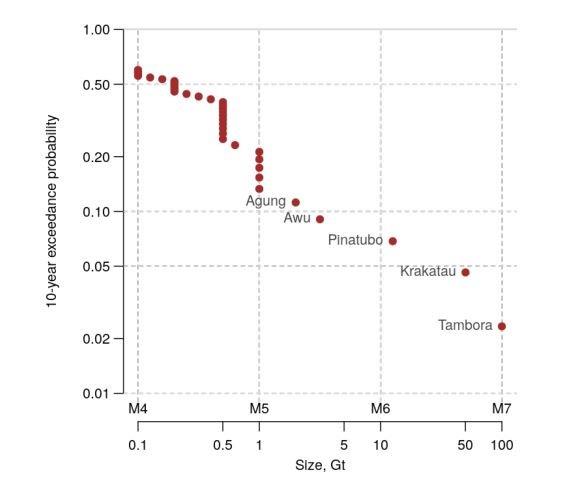The Northern Ireland local group of the RSS held a meeting on Tuesday, Feburary 4 2020 at 1pm in 6 College Park Ave, Queen's University Belfast. The speaker was Professor Jonathan Rougier, Independent Consultant, UK.
This talk was certainly topical given the recent White Island tragedy in New Zealand. The context that Professor Rougier was concerned with was that of the subject matter expert and the statistician providing a Hazard Assessment for the Risk manager. A recurring technical theme would be needed to make minimal model assumptions. For example, even the apparently innocuous Poisson assumption involved the notion of n independent random variables with a common continuous distribution function.
 Figure 1: Explosive eruptions in Indonesia, the Philippines and SE Asia (IPSEA) since 1600.
Figure 1: Explosive eruptions in Indonesia, the Philippines and SE Asia (IPSEA) since 1600.
Jonathan's idea was to weaken this approach by considering exchangeability in ranks (EiR). We were first asked to consider history of volcanic eruptions of length
h units and a future of length
f units. Jonathan presented the probability function PR (
X1 =
x; j, h, f) =:
w(x; j, h, f), yielding the probability that
X1 = 'the number of future events which are larger than the
jth largest historical event,' obtained under the exchangeable in ranks (EiR) assumption. The formula (omitted here) was not new, having first appeared in Gumbel and von Schelling (1950), in a rather different form. Importantly, the key exceedance probability (
P̄f(s) := Probability of at least one event larger than s int he next f years, could be estimated as 1 –
w(0; j, h, f), where
j = n-i-1 for i=1,...,n under EiR. He illustrated the use of 10-year exceedance probabilities by means of a graph (figure 1) which shows that there is about a 10% chance of an explosive event exceeding Agung (c2.5 Gt) int he next 10 years somewhere in IPSEA.
Professor Rougier went on to develop the EiR methodology in some detail, explaining that it offered a more general modelling framework with weaker assumptions than classical approaches. He developed a significance text for k-EiR methods and computed its power, which unfortunately was low with the histories available. He defined confidence anew as 'The smallest set of contiguous Exceedance Probability (EP) values containing at least 95% of the probability is the δ-year 95% prospective (
confidence) interval for the
f-year EP at the
ith ordered explosion size, s
(i), in the history.'
This was a very innovative talk extolling the virtues of new methodology designed to relax the stricter assumptions made by classical methods. It was very worthwhile and very well-received by a small but attentive audience. Professor Rougier dealt with questions on the effect (if any) of geographical units of differing sizes and with defining alternatives to
k-EiR which in the talk were only restricted to (
k –1)-EiR. When the questions died out Professor Rougier was thanked again by all those present.
Written by Professor Gilbert MacKenzie, Northern Ireland local group